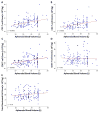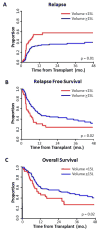Higher Donor Apheresis Blood Volumes Are Associated with Reduced Relapse Risk and Improved Survival in Reduced-Intensity Allogeneic Transplantations with Unrelated Donors
- PMID: 29408506
- PMCID: PMC5993582
- DOI: 10.1016/j.bbmt.2018.01.037
Higher Donor Apheresis Blood Volumes Are Associated with Reduced Relapse Risk and Improved Survival in Reduced-Intensity Allogeneic Transplantations with Unrelated Donors
Abstract
Allogeneic hematopoietic stem cell transplantation (HSCT) with reduced-intensity conditioning (RIC) offers a curative option for patients with hematologic malignancies who are unable to undergo myeloablative conditioning, but its success is limited by high rates of relapse. Several studies have suggested a role for T cell doses in peripheral blood stem cell grafts in RIC HSCT. Because T cell dose is typically not known until after the collection, and apheresis blood volume is easily modifiable, we hypothesized that higher donor apheresis blood volumes would improve transplantation outcomes through an effect on graft composition. Thus, we analyzed the relationships between apheresis volume, graft composition, and transplantation outcomes in 142 consecutive patients undergoing unrelated donor allogeneic RIC HSCT. We found that apheresis volume ≥15 L was associated with a significantly decreased risk of relapse (adjusted hazard ratio [aHR], .48; 95% confidence interval [CI], .28 to .84]; P = .01) and improved relapse-free survival (aHR, .56; 95% CI, .35 to .89; P = .02) and overall survival (aHR, .55; 95% CI, .34 to .91; P = .02). A high apheresis volume was not associated with increased rates of acute or chronic graft-versus-host disease. These results demonstrate that an apheresis volume of at least 15 L is independently predictive of improved transplantation outcomes after RIC allogeneic HSCT.
Keywords: Allogeneic; Apheresis; Reduced-intensity conditioning; Transplantation; Unrelated donor.
Copyright © 2018 The American Society for Blood and Marrow Transplantation. Published by Elsevier Inc. All rights reserved.
Figures




Similar articles
-
High Graft CD8 Cell Dose Predicts Improved Survival and Enables Better Donor Selection in Allogeneic Stem-Cell Transplantation With Reduced-Intensity Conditioning.J Clin Oncol. 2015 Jul 20;33(21):2392-8. doi: 10.1200/JCO.2014.60.1203. Epub 2015 Jun 8. J Clin Oncol. 2015. PMID: 26056179 Free PMC article.
-
Busulfan dose intensity and outcomes in reduced-intensity allogeneic peripheral blood stem cell transplantation for myelodysplastic syndrome or acute myeloid leukemia.Biol Blood Marrow Transplant. 2013 Jun;19(6):981-7. doi: 10.1016/j.bbmt.2013.03.016. Epub 2013 Apr 2. Biol Blood Marrow Transplant. 2013. PMID: 23562738
-
Poor outcome with nonmyeloablative conditioning regimen before cord blood transplantation for patients with high-risk acute myeloid leukemia compared with matched related or unrelated donor transplantation.Biol Blood Marrow Transplant. 2014 Oct;20(10):1560-5. doi: 10.1016/j.bbmt.2014.06.006. Epub 2014 Jun 14. Biol Blood Marrow Transplant. 2014. PMID: 24933658
-
Alloreactivity as therapeutic principle in the treatment of hematologic malignancies. Studies of clinical and immunologic aspects of allogeneic hematopoietic cell transplantation with nonmyeloablative conditioning.Dan Med Bull. 2007 May;54(2):112-39. Dan Med Bull. 2007. PMID: 17521527 Review.
-
Allogeneic hematopoietic stem cell transplantation (HSCT) after reduced intensity conditioning.Transfus Apher Sci. 2011 Apr;44(2):205-10. doi: 10.1016/j.transci.2011.01.019. Epub 2011 Feb 22. Transfus Apher Sci. 2011. PMID: 21345734 Review.
References
-
- Porter DL, Alyea EP, Antin JH, et al. NCI first international workshop on the biology, prevention, and treatment of relapse after allogeneic hematopoietic stem cell transplantation: Report from the committee on treatment of relapse after allogeneic hematopoietic stem cell transplantation. Biol Blood Marrow Transplant. 2010;16(11):1467–1503. doi: 10.1016/j.bbmt.2010.08.001. - DOI - PMC - PubMed
-
- Chen YB, Coughlin E, Kennedy KF, et al. Busulfan dose intensity and outcomes in reduced-intensity allogeneic peripheral blood stem cell transplantation for myelodysplastic syndrome or acute myeloid leukemia. Biol Blood Marrow Transplant. 2013;19(6):981–987. doi: 10.1016/j.bbmt.2013.03.016. - DOI - PubMed
Publication types
MeSH terms
Grants and funding
LinkOut - more resources
Full Text Sources
Other Literature Sources
Medical

